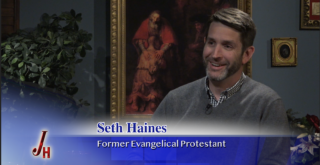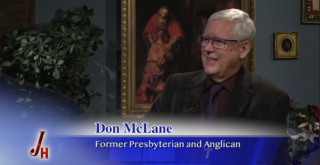
In the first installment of my advice as to how to avoid becoming a Catholic, I suggested two rules. First, assume that all Catholics are idiots. Second, get all your information about the Catholic Church second-hand. Steer clear of Catholic intellectuals, well-catechized laypeople, and young, zealous, orthodox priests and nuns. Look for leftover aging, hippy priests and nuns, poorly catechized Catholics, and ex-Catholics evangelicals who have it in for the Church. And above all, don’t read the Catechism of the Catholic Church.
With those preliminaries out of the way, the next three rules have to do with history.
Rule #3: Avoid Being “Deep in History”
Blessed John Henry Newman, an Anglican priest and scholar who entered the Church in 1845 and was eventually made a Cardinal, quipped, “To be deep in history is to cease to be Protestant.” And while it’s not a hard and fast rule, if you want to avoid the Catholic Church, do your best to avoid being “deep in history.”
Some history, of course, will do you no harm. Protestant history written by Protestant historians and the shenanigans of Borgia popes are good reading. But always assume that from the death of the last apostle until Martin Luther nailed the Ninety-Five Theses to the door at the Castle Church in Wittenberg there is nothing important to learn. After all, if the Church centered in Rome was utterly corrupt, there is no reason to study it except insofar as its corruption led to the Reformation.
This will allow you to think about the Reformation in purely spiritual terms. It was a great spiritual revival that struck a dead, corrupt, and calcified Church, met resistance, and finally broke free. That the renewal movement freed from its roots promptly hit the floor and shattered (and continues to shatter) into tens of thousands of smaller and sharper shards can be chalked up to there being “different kinds of gifts, but the same Spirit” (1 Corinthians 12:2).
By keeping the focus on the spiritual, you can avoid questions about greed and the politics of Europe. Princes who were caught up in the fervor of revival also managed to enrich their treasuries and their friends by shamelessly despoiling churches and monasteries. Rodney Stark in The Triumph of Christianity notes that during Henry VIII’s Reformation-like looting of the Church, “from the shrine dedicated to St. Thomas à Becket alone, Henry’s agents confiscated 4,994 ounces of gold, 4,425 ounces of silver gilt, 5,286 ounces of silver, and twenty-six cartloads of other treasure — and this was regarded as a trivial portion of the wealth confiscated from the church.”
It’s legitimate to ask what the Church was doing with such wealth, but regardless of the answer to that question, the fact remains that the state engaged in er… “wealth redistribution” or “repurposing” or… let’s be honest, they stole it.
Which brings up another inconvenient truth. The Reformation allowed the rulers of Europe to achieve what generations of kings yearned for: the total subjugation of the Church to the state. As long as the Church was one and centered in Rome, it served as a counterweight to the domineering aspirations of the state. Controlling the Catholic Church proved exceedingly difficult. But once the Church was reformed and shattered into bite-sized bits, controlling the bits was child’s play.
Cuius regio, eius religio (“Whose realm, his religion”) meant that the princes of Europe could and did make their churches into departments of government and their clergy into government bureaucrats. Membership in the national church became a mark, if not the defining mark, of patriotism. Kings appointed bishops and other church leaders who became his ecclesiastical lap dogs. And dissenters, be they Catholics or free church Protestants, were persecuted and/or treated as second-class citizens in some cases well into the nineteenth century.
Meanwhile the abuses that shocked and enraged Luther also shocked and enraged many good and godly clerics who remained in the Church. And while it’s true to say that the Reformation forced the issues, the Council of Trent (1545-1563) corrected most of the abuses and launched the Catholic Church into a new era of spiritual, intellectual, and missionary vigor. Meanwhile the shattered chunks of Protestantism did as they were told.
Rail against my wrong-headed reading of the history if you wish, but keep it to ad hominem attacks. If you start reading more broadly from Catholic as well as Protestant sources it will only cause you to get “deep in history.” When that happens, don’t say that Blessed John Henry didn’t warn you.
Rule #4: Do Not Read the Church Fathers
Our small group began meeting just before Advent. “Why don’t we read St. Athanasius’s book On the Incarnation?” I suggested.
“Athanasius?” said one of the group members, “Wasn’t he Catholic?”
How exactly do you answer that question? Yes, of course, Athanasius is a Catholic. But what my friend meant was Catholic as opposed to Protestant. That distinction 1,100 years before the Reformation is more than anachronistic, it’s absurd. Athanasius belongs to all Christians. He was, after all, in the front lines of the battle defending the deity of Christ from the Arians. The Arian belief that Jesus was not God, but a sort of super-duper angel was taking over the Church one city at a time and if it had prevailed, we wouldn’t be having this conversation. Athanasius is one of Christianity’s greatest heroes. He belongs to us all.
And Polycarp, Ignatius of Antioch, Clement of Rome, Gregory of Nyssa, John Chrysostom, Anthony, Augustine of Hippo, and the rest of the Church Fathers stretching from the early second century into about the seventh century belong to us all as well. They laid the foundation for all genuinely Christian theology and many were involved in writing the creeds that we still recite—or at least, that some of us still recite.
That makes reading the Fathers sound mighty attractive, but consider: most of them were bishops and some, Clement of Rome for example, were popes. Resist the temptation since they will demand that you think seriously about many things including Church government and why yours is probably not biblical.
There are three church polity “options”: government by bishops or episcopal (from the Greek word episcopos meaning overseer or bishop), government by elders or presbyterian (from the Greek word presbyteros meaning elder), and congregational (who don’t get a Greek word).
Like many, I left seminary believing that church government didn’t even make it to the level of a tertiary concern. The New Testament talks about bishops and elders in ways that I saw as interchangeable. It seemed clear to me that the New Testament congregations were run locally with elders/overseers or whatever they wanted to call themselves aided by deacons. Apostles, being the authoritative conduits for Christian truth, could and did have special input, but then they died. Did I mention that I was a licensed Congregational minister at the time?
Reading the early Church Fathers makes clear that a matter of a few decades after the apostles and all across the Church there was a hierarchy of bishops, priests (presbyters), and deacons.
There are only two ways to explain this.
Explanation #1: The apostles had no strong opinions about church polity and the New Testament is intentionally ambiguous so that congregations could pick what worked best for them. (Alternative Explanation #1 reflecting my Presbyterian years: The apostles writing the New Testament intended Presbyterian polity, Acts 15 being the minutes of the first General Assembly.) Then as soon as the last apostle went to his reward, the Church from Jerusalem to Antioch, from Ephesus to Corinth, across North Africa to Rome underwent a massive reorg that instituted episcopal polity everywhere complete with the doctrine of apostolic succession. And, unlike every other reorg in history and unlike every other change in the early Church, no one complained.
Sure, it could happen.
Explanation #2: The apostles set up a hierarchical system of bishops, priests, and deacons complete with the doctrine of apostolic succession and we need to read the relevant New Testament texts in light of that and adopt the same system today.
Writing in the late second century bishop and theologian St. Irenaeus said, “[I]t is incumbent to obey the presbyters who are in the Church—those who, as I have shown, possess the succession from the apostles; those who, together with the succession of the episcopate, have received the infallible charism of truth, according to the good pleasure of the Father.”
The Church Fathers are full of disturbing stuff like that. If you must read them, read them as quoted in Calvin and Luther. Taken on their own, they’re disturbing.
Rule #5: Affirm “The Great Tradition,” but Don’t Ask What’s Included in the Great Tradition
Connected to the Church Fathers is the Great Tradition, something that has made a comeback recently in the thinking of evangelicals. For example, the Urban Ministry Institute, a division of the evangelical ministry World Impact, wants to revive the Great Tradition. They write [2]:
As the roots of our orthodox faith, the Great Tradition is grounded in the Apostolic Tradition set in the bounds of the historic orthodox faith as defined and asserted in the ecumenical creeds of the ancient and undivided Church, with special focus on the Nicene Creed. It confesses the Ancient Rule of Faith, the core Christian confession expressed in that adage of [the fifth century monk] Vincent of Lerins: “that which has always been believed, everywhere, and by all.”
Some evangelical leaders have begun espousing theology somewhere between wobbly and downright heretical. Somehow it has escaped these “post-conservative evangelicals” (sounds like an oxymoron to me) that they’re repeating the errors the Protestant Mainline churches made over a century ago, errors that caused them to slip from mainline to oldline to sideline to what they are today: side show. Nonetheless, since no one gets published by agreeing with everybody else, evangelical theology is being kicked down the slippery slope into the same subjectivity, private judgment, and irrelevance that marks its mainline cousin.
Traditional evangelicals trying to do damage control feel a need to put a hedge around the Scripture and around orthodox theology. The chosen hedge for some is the Great Tradition. As one evangelical thinker writes [3], “Scripture is primary, but the Great Tradition is the authoritative guide to its interpretation.” Unless evangelicals accept this, he goes on, “[evangelicalism] will risk disintegrating into ever more subjectivist and individualistic sects, many of them neither evangelical nor orthodox.”
Now an evangelical appealing to the authority of the Church is already more than just a little strange. But beyond that, when he affirms the Great Tradition, what he really wants is orthodox Trinitarian theology and Christology as expressed in the Apostles’ and Nicene Creeds. And while I’m all for that, it’s a very Protestant pick-and-choose approach to something larger than the Creeds.
If we are to follow Vincent of Lerins’ rule of “that which has always been believed, everywhere, and by all,” we can’t stop with the Trinity and the two natures of Christ. We need to take it all.
As pointed out in Rule #4, above, the Great Tradition includes bishops and apostolic succession. Hence, the Church is “one, holy, and apostolic.” Reinterpreting apostolic as “based on the writings of the apostles,” that is, “biblical” really isn’t an option particularly if you’re going to affirm the Great Tradition to keep others from doing the same sort of reinterpreting to the Bible.
The Great Tradition includes the real real presence of Christ in the Eucharist, not some sort of spiritual real presence. In his book The Spirit of Early Christian Thought,Robert Louis Wilken quotes Justin Martyr (AD 103-165): “So also we have been taught that the food consecrated by the word of prayer which comes from him, from which our flesh and blood are nourished by being renewed, is the flesh and blood of that incarnate Jesus.” If you want the Great Tradition, “symbolic presence” and “spiritual presence” were not options and neither is the notion that the Lord’s Supper is an “ordinance” rather than a “sacrament.”
The Great Tradition includes “the communion of the saints” of which prayer to the saints for their intercession is a necessary part. For example, St. Basil the Great (AD 329-379) wrote, “I acknowledge also the holy apostles, prophets, and martyrs; and I invoke them to supplication to God, that through them, that is, through their mediation, the merciful God may be propitious to me, and that a ransom may be made and given me for my sins.” Not that invoking the saints—St. Basil in particular—isn’t a bad idea for evangelicals in theological crisis.
Finally, the package deal includes what most evangelicals affirming the Great Tradition would probably consider the most disturbing: Mary. The Church believed “everywhere, and by all” that Mary is the new Eve, remained a virgin after Jesus’ birth, was bodily assumed into Heaven, is rightly called Mother of God (Theotokos), and intercedes for us. Christians as early as AD 300 prayed: “We fly to your patronage, O holy Theotokos; despise not our petition in our necessities, but deliver us always from all dangers, O ever-glorious and blessed Virgin.”
I could go on, but you get the idea.
Traditional evangelicals have a desperate need to set a hedge around sola scriptura in these post-modern days. And I believe the Great Tradition is precisely what they need. But, then again, I’m a Catholic.










